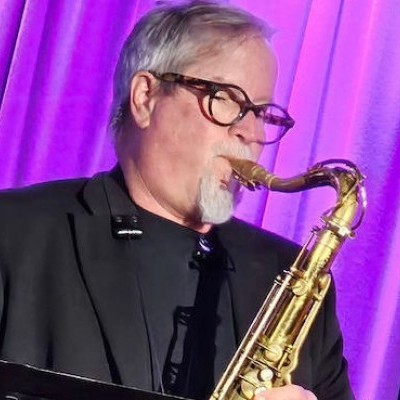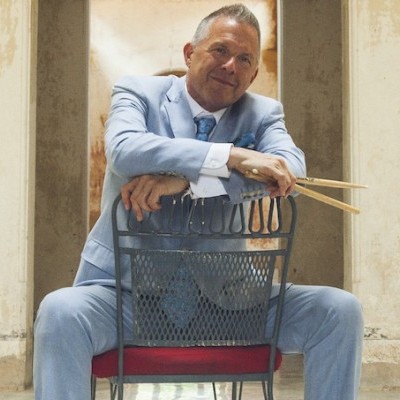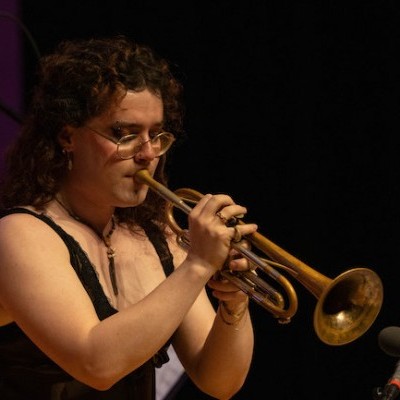Oct 28, 2025 10:47 AM
In Memoriam: Jack DeJohnette, 1942–2025
Jack DeJohnette, a bold and resourceful drummer and NEA Jazz Master who forged a unique vocabulary on the kit over his…

When John Hollenbeck started releasing music, the streaming economy didn’t exist.
(Photo: Mercedes Jelinek)By his own admission, John Hollenbeck was a percussion nerd at a young age, obsessed with the idea of becoming a big-band drummer when he was a 12-year-old living in New York State’s Southern Tier region. During the past 40 years, his career has blossomed well beyond those original intentions, to encompass work leading his large ensemble, The Claudia Quartet, various duo and small-group collaborations, composing and teaching.
Today, like numerous contemporary artists, he has added entrepreneurship to his skill set, launching a nonprofit called Flexatonic Arts to represent his various initiatives along with those developed by others in his immediate circle.
For this latest project, Hollenbeck turned to Marty Khan, the co-founder of Outward Visions, who has helped organize nonprofits for other jazz players, including Oliver Lake’s Passin’ Thru, George Russell’s Concept, Inc., and Craig Harris’ Nation of Imagination.
“It’s a little bit of an experiment,” said Hollenbeck on a Zoom call from Montreal, where he’s a professor at McGill University’s Schulich School of Music. “I realized that what I do is not based in consumerism, but in art. It’s not necessarily about products; it’s more about creativity, education and community.”
He traces this current experiment back to an experience he had while teaching in Germany at the Jazz Institute Berlin: “I was surprised that none of my students knew Jan Garbarek’s music. [But] at the time, none of ECM’s recordings were on streaming platforms. And when they did become available, it seemed like overnight all my students knew about him.”
Considering his own early works—on labels like Composers Recordings Inc., OmniTone and Cuneiform—Hollenbeck began thinking seriously about repatriating records he didn’t control.
“When I put these records out, streaming platforms didn’t even exist, and then all of a sudden, I looked on a streaming platform and there was my record,” he said. “I was like, ‘Whoa! That’s weird,’ because, of course, we never even discussed it at the time. But I felt like, ‘I want this. I want to get this to these people.’”
Now, via Flexatonic, listeners can purchase early albums like No Images—a 2001 album on CRI that included his brilliant reconceptualization of a 1968 speech by Rev. Martin Luther King Jr., a project Hollenbeck conceived of while a student at the Eastman School of Music—and midperiod works like 2009’s Eternal Interlude, scored for a 19-piece orchestra and vocalist Theo Bleckmann. Proceeds from the recordings on Bandcamp are being donated to Black Lives Matters initiatives for the foreseeable future.
Bleckmann, who met Hollenbeck at guitarist Ben Monder’s Brooklyn apartment in the mid-’90s and has collaborated with him for about 25 years, said it’s the composer’s restless curiosity about sonic possibilities that has inspired their long musical relationship.
“It has evolved from just trying stuff out to making those ideas much bolder and really owning them,” the singer said. “We both always come together with new ideas, and I would never correct or stop him, unless something’s completely out of my range or impossible to do for some physical reason. I’ve always been like, ‘Let’s make this work in some way.’ It’s exciting.”
Their most recent collaboration is Songs You Like A Lot, which also features vocalist Kate McGarry, keyboardist Gary Versace and the Frankfurt Radio Big Band. The follow-up to 2013’s Songs I Like A Lot and Songs We Like A Lot from 2015, the new project includes Hollenbeck’s idiosyncratic arrangements of songs suggested by online votes. His approach to compositions as diverse as the hymn “Down To The River To Pray,” Joni Mitchell’s “Blue” and Peter Gabriel’s “Don’t Give Up” showcases a seemingly boundless imagination and signature willingness to explore unlikely sonic choices.
“I think John is really, really good at balancing the risky behavior and big-band writing with attending to everybody’s need and desire to be heard in a large ensemble,” said Bleckmann. “His approach is really incredible.”
Part of that approach is to continually push himself into new settings.
“I guess I have a hard time saying no,” Hollenbeck said. “But from a practical standpoint, it’s often just that I offer promoters my large ensemble and they’ll be like, ‘Well, we can’t afford something that large,’ and I’ll offer them The Claudia Quartet, and then discussions go from there, and that can lead to interesting things.”
For Hollenbeck, like many others, a lot of interesting things were quashed by the COVID-19 outbreak. That meant scuttling a quartet performance of his composition “Epigraphs” in Australia, a residency in Finland and extensive work with his long-time collaborator Meredith Monk.
When DownBeat spoke with Hollenbeck, he and his wife were just finishing a 14-day quarantine in Montreal after spending time in his hometown of Binghamton. At the time, the drummer was contemplating what the new school year would look like.
“I loved the utopian school environment when I was young,” he said. “I never wanted to leave. I love being able to walk into a library and just hang out and find new things.”
But the best thing about the academic setting, he concluded, was the continuing challenge to learn.
The 12-year-old drum nerd re-emerges, saying, “I remember, I took [Kneebody drummer] Nate Wood out for Japanese food because I needed to know—I needed to know—what were the best exercises he ever did. I wanted to figure out what are the things that could help a student the most. You end up thinking about yourself a lot and what you do and how you do it. You’re constantly examining yourself, which I think it is good.” DB
Correction: A previous version of this story misidentified Hollenbeck’s wife. The drummer is married to Kate Schroeder.

Jack DeJohnette boasted a musical resume that was as long as it was fearsome.
Oct 28, 2025 10:47 AM
Jack DeJohnette, a bold and resourceful drummer and NEA Jazz Master who forged a unique vocabulary on the kit over his…

“I’ve told students, ‘I don’t mind if you use AI for this or that project,’” says MIT’s Pascal Le Boeuf. “‘But you need to tell me.’”
Sep 18, 2025 11:14 AM
A standard joke when it comes to discussing artificial intelligence, or AI, is that it’s developing so rapidly that…

Chuck Manning Works for NASA … and plays jazz.
Sep 18, 2025 11:23 AM
Congratulations! After years of study, you’ve earned your degree in jazz performance. But let’s face it: Making a…

Always a sharp dresser, Farnsworth wears a pocket square given to him by trumpeter Art Farmer. “You need to look good if you want to hang around me,” Farmer told him.
Sep 23, 2025 11:12 AM
When he was 12 years old, the hard-swinging veteran drummer Joe Farnsworth had a fateful encounter with his idol Max…

“Make time and energy to meet people and make friends,” suggests Millie Ahearn, a student at DePaul University.
Sep 18, 2025 11:32 AM
For many students, the transition into a collegiate jazz program can feel overwhelming — new peers, unfamiliar…